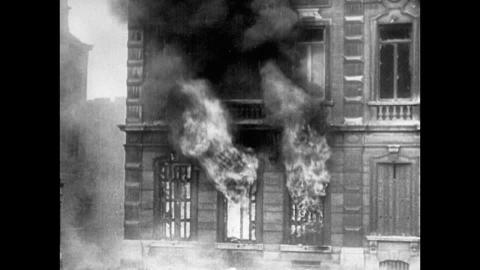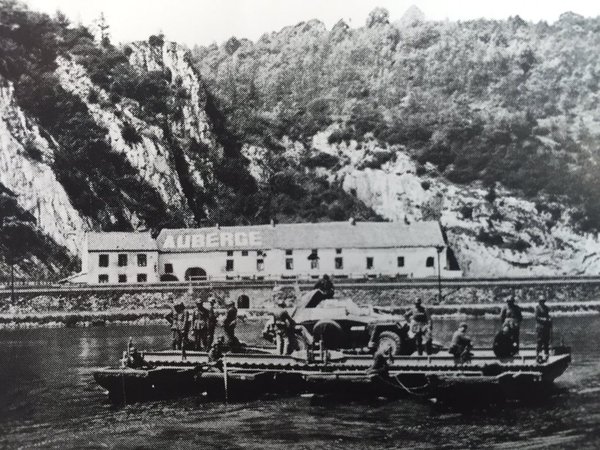Tuesday 14 May 1940
 |
| 1st Panzer Regiment crosses the Meuse near Sedan, 14 May 1940. |
Meanwhile, Hitler issues Fuhrer Directive No. 11. It essentially just commands that the Dutch are to be defeated, which is happening swiftly anyway. Events on the ground are happening faster than the Generals and dictators can keep up with.
Late in the day, the Dutch surrender in all provinces except Zeeland, where they continue to fight. They have lost 2300 KIA, 7000 wounded, 3000 civilians dead. The Germans on that front have lost 2900 KIA, 7000 wounded and 1300 paratroopers captured and taken to Great Britain.
Within the city of Sedan itself, the last French holdouts surrender after dark. Local French counterattacks fail.
Among other things, the breakthrough over the Meuse threatens the Belgian K-W Line. This recent defensive line (first established after the beginning of the war) starts with the National Redoubt at Antwerp runs south along the River Dijle, then to just behind the main Fortified Position of Liège. Travel on the roads is becoming virtually impossible, as they are clogged with an estimated 2 million refugees.
The German General Rudolf Schmidt reaches the Nieuwe Maas River and issues a surrender ultimatum in Rotterdam. He threatens a Luftwaffe assault. The Mayor of Rotterdam refuses any civilian evacuation, stating, "It would only cause panic." The Luftwaffe appears quickly - before the surrender ultimatum has expired - with around 50-100 Heinkel He 111 bombers (sources vary). They drop 95 tons of bombs, causing huge fires. There are estimates of over 800 dead and 85,000 homeless (all figures vary and are very tentative, probably higher). Rotterdam surrenders after much needless damage and loss of life, with Army Commander-in-chief General Winkelman himself broadcasting the local ceasefire, which includes Utrecht. Fighting continues in Zeeland, where Dutch troops are fighting with the French.
General Guderian's panzer divisions are across the Meuse. Allied air attacks against the pontoon bridges achieve little.
Guderian wants to sprint forward with his mobile forces - the opening is there. Previously on 12 May, he had requested permission to establish a large bridgehead. The OKW has been considering this, but this morning at 11:45 Guderian's superior General von Kleist rejects his request and orders him to maintain a bridgehead of 8 km (5 miles). However, Guderian slyly gets von Kleist, who is almost certainly only parroting what Hitler has ordered, to agree that he may engage in "reconnaissance in force" (Guderian threatens to resign, which is a fairly common tactic of his). The result is that there is no halt order, and Guderian sprints ahead anyway - to his own glory or peril, as the case may be.
Guderian, however, has more in mind than just lunging westward. He sends the 10th Panzer Division and Großdeutschland infantry regiment southeast in a feint to take the Maginot Line from the rear. French General Huntziger was going to use the direction - the same road, in fact - to attack Guderian's left flank. The German panzers run head-on into the armored 3e Division Cuirassée (DCR) at the Stonne plateau. This results in a stalemate on the German flank, with the main Wehrmacht effort to the west unhindered.
Guderian's westward thrust is wildly successful. He eviscerates the French Sixth Army west of Sedan, eliminating the flank protection of the French Ninth Army. The entire French Ninth Army collapses and begins to surrender. This unhinges the flank of the French 102nd Fortress Division at Monthermé, which the 6th and 8th Panzer Divisions destroy.
Slightly to the north, Erwin Rommel and his 7th "Ghost" Panzer Division of German 4th Army are across the Meuse. He drives the Allied troops back 3 miles to Onhaye, narrowly avoiding major injury (he has a shell splinter in his cheek). He breaks through the French Second Army, heading southwestward to Philippeville.
The French order some portions of the vaunted Maginot Line which have been outflanked to retreat. This demoralizes the troops involved, who believe in the fortifications. Most of the Maginot Line to the south, however, remains intact and unbreached.
Further north, General Erich Hoepner is being delayed more than anywhere else, and he wants results. General Stumpff leads his 3rd Panzer Division against the new French 1st Army line at Gembloux and General Sever leads his 4th Panzer Division against the same line at Perwez. The attack fails under heavy artillery fire until the German infantry catches up, at which point they make some progress. The battle is a minor French victory, as the Germans have been stalled all day long and both sides have lost numerous tanks. The Germans must attack again on the morrow, with the 4th Panzer Division in a better position than 3rd.
At Grebbeberg, the Dutch line has collapsed and they are in full retreat to the Waterline position. The Dutch move quickly and establish their new defensive position with 6 divisions by morning. The Germans are slow to pursue but have won the Grebbeberg battle, eliminating the best defensive positions in the sector. Both sides lost 200-400 men killed in the battle, with the Dutch faring worse.
At the Afsluitdijk in the far north, the Germans once again begin an artillery barrage in the morning as preparation for an attack. The Dutch fire from the sloop HNLMS Johan Maurits van Nassau in the Wadden Sea, which arrived during the night (and which the Germans don't know about). The sloop's 150 mm (5.9 inches) guns are devastating against the German artillery, silencing it within an hour. The German commander, General Kurt Feldt, breaks off the attack. How many German troops perished is subject to wildly different estimates from either side, the Germans claiming 5 deaths and 25 wounded, while local civilians claimed to see literally hundreds of dead bodies.
European Air Operations: The Luftwaffe is busy with the Blitzkrieg. Bf 109s have a field day picking off Allied bombers, as the Allies are sending everything they have - dozens of bombers - in broad daylight in a frantic effort to stop the Meuse river crossings. The Luftwaffe fighters shoot down 45 RAF bombers and 5 French bombers (many obsolete Fairey Battles and Amiot 143s) (sources vary). At the end of the day, the bridges are intact, the allied air forces somewhat less so.
During the night, RAF Bomber Command sends 30 bombers to attack Monchengladbach and Aachen, reiterating the decision to bomb civilians.
The RAF sends 22 aircraft out to lay mines after dark.
Battle of the Atlantic: The Dutch scuttle numerous ships at Rotterdam to keep them out of German hands, including destroyers Tjerk Hiddes and Gerald Callenburgh and submarine O-12. The Germans do capture submarines O-26 and O-8.
The Germans also capture submarine O-25 at Schiedam.
The Luftwaffe makes several attacks against Dutch shipping, sinking Dutch gunboats Johan Maurits van Nassau and Brinio (scuttled).
Dutch transport Texelstroom gets away with 300 German POWs.
Convoy OA 148GF departs from Southend, Convoy OB 148 departs from Liverpool.
Norway: The British 24th Guards Brigade is on a transport heading to Mo i Rana south of Narvik when it is bombed. The ship is so badly damaged that it immediately departs for Scapa Flow, carrying the entire Brigade with it. As the force's commanding General, Brigadier Williams, on the ship, the person left in overall command of the force is Colonel Gubbins.
Junkers Ju 52s drop 66 1st Fallschirmjaeger Regiment troops at Narvik.
British Government: The new Minister of Aircraft Production is Lord Beaverbrook.
Secretary for War Anthony Eden broadcasts an appeal for volunteers to fill the Local Defence Volunteers (later renamed the Home Guard). Their role is to guard against German parachute landings.
 |
| Fires in Rotterdam, 14 May 1940. |
May 1940
May 1, 1940: British Leave ÅndalsnesMay 2, 1940: British Depart Namsos
May 3, 1940: Many Norwegians Surrendering
May 4, 1940: Bader Returns
May 5, 1940: HMS Seal Survives
May 6, 1940: Allies Focus on Narvik
May 7, 1940: In The Name of God, Go!
May 8, 1940: Exit Chamberlain
May 9, 1940: Enter Churchill
May 10, 1940: Fall Gelb
May 11, 1940: Eben Emael Surrenders
May 12, 1940: Germans at Sedan
May 13, 1940: Rommel at Work
May 14, 1940: German Breakout in France
May 15, 1940: Holland Surrenders
May 16, 1940: Dash to the Channel
May 17, 1940: Germans Take Brussels
May 18, 1940: Germans Take Antwerp
May 19, 1940: Failed French Counterattack
May 20, 1940: Panzers on the Coast
May 21, 1940: Battle of Arras
May 22, 1940: Attacking Channel Ports
May 23, 1940: British Evacuate Boulogne
May 24, 1940: Hitler's Stop Order
May 25, 1940: Belgian Defenses Creaking
May 26, 1940: Operation Dynamo
May 27, 1940: King Leopold Surrenders
May 28, 1940: The Allies Take Narvik
May 29, 1940: Lille Falls
May 30, 1940: Operation Fish
May 31, 1940: Peak Day for Dynamo
2019



